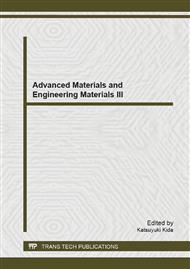p.436
p.440
p.444
p.449
p.457
p.461
p.467
p.472
p.478
Separation of Trace Heavy Metal Ions from Leaching Liquor of Low-Grade Pyrolusite with Pyrite and H2SO4
Abstract:
Separation of trace heavy metal ions with BaS from solutions of five kinds of systems was studied. One was prepared with the solution (called as original solution here) leached from pyrolusite with pyrite and H2SO4, and the other four kinds of systems were prepared in the laboratory according to the composition of the original solution. They are respectively: a ternary system of NiSO4CoSO4ZnSO4; two quaternary systems of (NH4)2SO4NiSO4CoSO4ZnSO4 and MnSO4NiSO4CoSO4ZnSO4; a quintuple system of MnSO4(NH4)2SO4NiSO4CoSO4ZnSO4. The experiments have researched the effect of reaction time and dosage of BaS on the separation of heavy metal ions. According to the results, it took the five systems 10minutes to reach the equilibrium state and re-dissolution was found in the results. As the increasing of BaS dosage, the residual heavy metal ions would reduce, but the results of five systems were different when the same BaS was used.
Info:
Periodical:
Pages:
457-460
Citation:
Online since:
February 2014
Authors:
Keywords:
Price:
Сopyright:
© 2014 Trans Tech Publications Ltd. All Rights Reserved
Share:
Citation:


